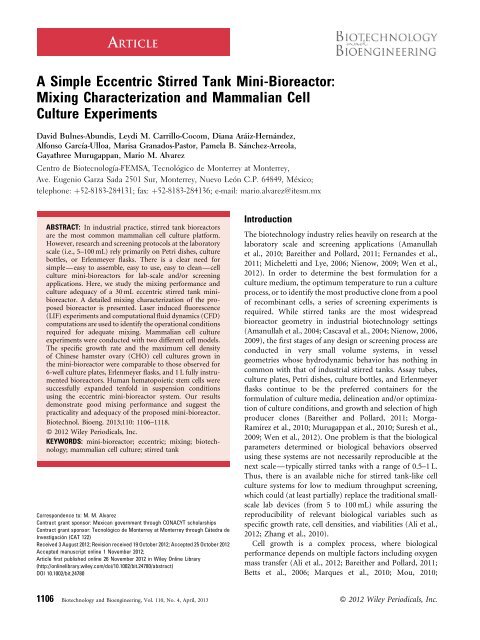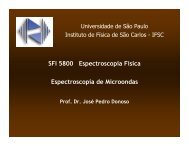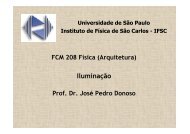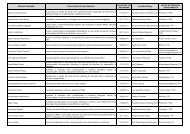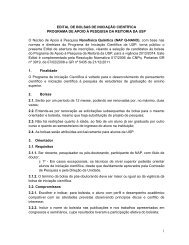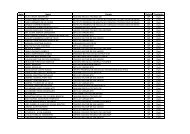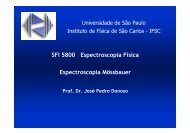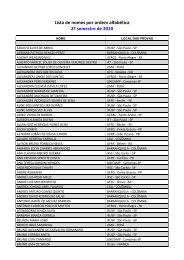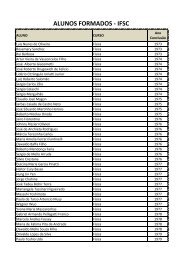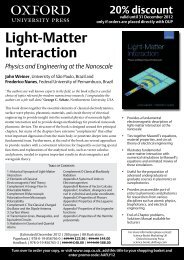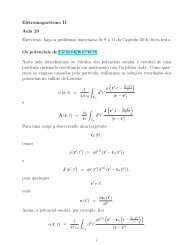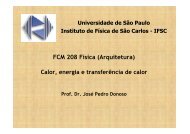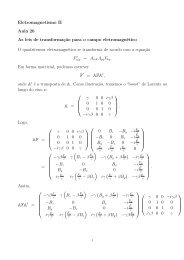Mixing characterization and mammalian cell culture ... - IFSC
Mixing characterization and mammalian cell culture ... - IFSC
Mixing characterization and mammalian cell culture ... - IFSC
You also want an ePaper? Increase the reach of your titles
YUMPU automatically turns print PDFs into web optimized ePapers that Google loves.
ARTICLE<br />
A Simple Eccentric Stirred Tank Mini-Bioreactor:<br />
<strong>Mixing</strong> Characterization <strong>and</strong> Mammalian Cell<br />
Culture Experiments<br />
David Bulnes-Abundis, Leydi M. Carrillo-Cocom, Diana Aráiz-Hernández,<br />
Alfonso García-Ulloa, Marisa Granados-Pastor, Pamela B. Sánchez-Arreola,<br />
Gayathree Murugappan, Mario M. Alvarez<br />
Centro de Biotecnología-FEMSA, Tecnológico de Monterrey at Monterrey,<br />
Ave. Eugenio Garza Sada 2501 Sur, Monterrey, Nuevo León C.P. 64849, México;<br />
telephone: þ52-8183-284131; fax: þ52-8183-284136; e-mail: mario.alvarez@itesm.mx<br />
ABSTRACT: In industrial practice, stirred tank bioreactors<br />
are the most common <strong>mammalian</strong> <strong>cell</strong> <strong>culture</strong> platform.<br />
However, research <strong>and</strong> screening protocols at the laboratory<br />
scale (i.e., 5–100 mL) rely primarily on Petri dishes, <strong>culture</strong><br />
bottles, or Erlenmeyer flasks. There is a clear need for<br />
simple—easy to assemble, easy to use, easy to clean—<strong>cell</strong><br />
<strong>culture</strong> mini-bioreactors for lab-scale <strong>and</strong>/or screening<br />
applications. Here, we study the mixing performance <strong>and</strong><br />
<strong>culture</strong> adequacy of a 30 mL eccentric stirred tank minibioreactor.<br />
A detailed mixing <strong>characterization</strong> of the proposed<br />
bioreactor is presented. Laser induced fluorescence<br />
(LIF) experiments <strong>and</strong> computational fluid dynamics (CFD)<br />
computations are used to identify the operational conditions<br />
required for adequate mixing. Mammalian <strong>cell</strong> <strong>culture</strong><br />
experiments were conducted with two different <strong>cell</strong> models.<br />
The specific growth rate <strong>and</strong> the maximum <strong>cell</strong> density<br />
of Chinese hamster ovary (CHO) <strong>cell</strong> <strong>culture</strong>s grown in<br />
the mini-bioreactor were comparable to those observed for<br />
6-well <strong>culture</strong> plates, Erlenmeyer flasks, <strong>and</strong> 1 L fully instrumented<br />
bioreactors. Human hematopoietic stem <strong>cell</strong>s were<br />
successfully exp<strong>and</strong>ed tenfold in suspension conditions<br />
using the eccentric mini-bioreactor system. Our results<br />
demonstrate good mixing performance <strong>and</strong> suggest the<br />
practicality <strong>and</strong> adequacy of the proposed mini-bioreactor.<br />
Biotechnol. Bioeng. 2013;110: 1106–1118.<br />
ß 2012 Wiley Periodicals, Inc.<br />
KEYWORDS: mini-bioreactor; eccentric; mixing; biotechnology;<br />
<strong>mammalian</strong> <strong>cell</strong> <strong>culture</strong>; stirred tank<br />
Correspondence to: M. M. Alvarez<br />
Contract grant sponsor: Mexican government through CONACYT scholarships<br />
Contract grant sponsor: Tecnológico de Monterrey at Monterrey through Cátedra de<br />
Investigación (CAT 122)<br />
Received 3 August 2012; Revision received 19 October 2012; Accepted 25 October 2012<br />
Accepted manuscript online 1 November 2012;<br />
Article first published online 26 November 2012 in Wiley Online Library<br />
(http://onlinelibrary.wiley.com/doi/10.1002/bit.24780/abstract)<br />
DOI 10.1002/bit.24780<br />
Introduction<br />
The biotechnology industry relies heavily on research at the<br />
laboratory scale <strong>and</strong> screening applications (Amanullah<br />
et al., 2010; Bareither <strong>and</strong> Pollard, 2011; Fern<strong>and</strong>es et al.,<br />
2011; Micheletti <strong>and</strong> Lye, 2006; Nienow, 2009; Wen et al.,<br />
2012). In order to determine the best formulation for a<br />
<strong>culture</strong> medium, the optimum temperature to run a <strong>culture</strong><br />
process, or to identify the most productive clone from a pool<br />
of recombinant <strong>cell</strong>s, a series of screening experiments is<br />
required. While stirred tanks are the most widespread<br />
bioreactor geometry in industrial biotechnology settings<br />
(Amanullah et al., 2004; Cascaval et al., 2004; Nienow, 2006,<br />
2009), the first stages of any design or screening process are<br />
conducted in very small volume systems, in vessel<br />
geometries whose hydrodynamic behavior has nothing in<br />
common with that of industrial stirred tanks. Assay tubes,<br />
<strong>culture</strong> plates, Petri dishes, <strong>culture</strong> bottles, <strong>and</strong> Erlenmeyer<br />
flasks continue to be the preferred containers for the<br />
formulation of <strong>culture</strong> media, delineation <strong>and</strong>/or optimization<br />
of <strong>culture</strong> conditions, <strong>and</strong> growth <strong>and</strong> selection of high<br />
producer clones (Bareither <strong>and</strong> Pollard, 2011; Morga-<br />
Ramírez et al., 2010; Murugappan et al., 2010; Suresh et al.,<br />
2009; Wen et al., 2012). One problem is that the biological<br />
parameters determined or biological behaviors observed<br />
using these systems are not necessarily reproducible at the<br />
next scale—typically stirred tanks with a range of 0.5–1 L.<br />
Thus, there is an available niche for stirred tank-like <strong>cell</strong><br />
<strong>culture</strong> systems for low to medium throughput screening,<br />
which could (at least partially) replace the traditional smallscale<br />
lab devices (from 5 to 100 mL) while assuring the<br />
reproducibility of relevant biological variables such as<br />
specific growth rate, <strong>cell</strong> densities, <strong>and</strong> viabilities (Ali et al.,<br />
2012; Zhang et al., 2010).<br />
Cell growth is a complex process, where biological<br />
performance depends on multiple factors including oxygen<br />
mass transfer (Ali et al., 2012; Bareither <strong>and</strong> Pollard, 2011;<br />
Betts et al., 2006; Marques et al., 2010; Mou, 2010;<br />
1106 Biotechnology <strong>and</strong> Bioengineering, Vol. 110, No. 4, April, 2013 ß 2012 Wiley Periodicals, Inc.
Nikakhtari <strong>and</strong> Hill, 2006), temperature <strong>and</strong> pH control,<br />
nutrient availability, <strong>and</strong> so on. Most of these are highly<br />
influenced by mixing performance. Achieving good mixing<br />
in small volumes, however, is not a straightforward process<br />
(Ali et al., 2012; Bareither <strong>and</strong> Pollard, 2011; Wen et al.,<br />
2012). The typical stirred tank geometries used in industrial,<br />
pilot plant, or lab-scale biotechnology applications normally<br />
rely on turbulence as a mixing mechanism (Cascaval et al.,<br />
2004). Nonetheless, at smaller scales—that is in screening<br />
bioreactors—turbulence involves practical problems. While<br />
in 1 L tanks, agitation values in the range of 100–600 are<br />
sufficient to promote turbulent conditions in aqueous<br />
environments, in small systems, much higher agitation values<br />
are needed to achieve equivalently turbulent conditions.<br />
To assure adequate oxygen mass transfer in a small-scale<br />
stirred tank is also difficult. In larger systems, agitation with<br />
turbines causes turbulence. Under turbulent conditions,<br />
oxygen dosed through fine spargers is correctly dispersed<br />
<strong>and</strong> typical bubble sizes <strong>and</strong> residence times allow for<br />
sufficient oxygen mass transfer. As the scale is reduced, a<br />
shorter residence time for air bubbles is expected, <strong>and</strong><br />
adequate gas dispersion will dem<strong>and</strong> higher shear rates. In<br />
addition, more bubbles per time unit will reach the surface<br />
of the tank, trapping <strong>cell</strong>s at their surface. Both high shear<br />
rates <strong>and</strong> bubble bursting have been studied as possible<br />
factors for lethal <strong>and</strong> sub-lethal damage to <strong>mammalian</strong> <strong>cell</strong>s<br />
(Amanullah et al., 2004; Chisti, 2000; Godoy-Silva et al.,<br />
2009; Keane et al., 2003; Nienow, 2006). This framework<br />
precludes the use of typical impeller designs <strong>and</strong> gas<br />
dispersion strategies for aerobic processes at very small<br />
scales. Hence, in stirred tanks, as the scale is reduced, gas<br />
transfer through the liquid surface becomes the ideal<br />
mechanism for gas–liquid mass transfer. However, in typical<br />
stirred tank geometries, the liquid surface/volume ratio<br />
is relatively low compared to that in Petri dishes, <strong>culture</strong><br />
bottles, or Erlenmeyer flasks. Therefore, axial circulation<br />
<strong>and</strong> liquid surface renewal should be enhanced to make<br />
aerobic <strong>cell</strong> <strong>culture</strong> feasible in small-scale stirred tanks<br />
without using air bubbling (see also Mou, 2010).<br />
In this study, we propose a simple stirred tank system to<br />
be used as a bioreactor for lab-scale <strong>and</strong>/or screening<br />
<strong>mammalian</strong> <strong>cell</strong> <strong>culture</strong> applications. Its mixing performance<br />
as a <strong>cell</strong> <strong>culture</strong> vessel is validated through<br />
experimental flow pattern visualization, computational<br />
fluid dynamics (CFD) simulations, <strong>and</strong> <strong>culture</strong> experiments<br />
using <strong>mammalian</strong> <strong>cell</strong>s (CHO <strong>cell</strong>s <strong>and</strong> hematopoietic stem<br />
<strong>cell</strong>s).<br />
Until recently, mixing in small-scale stirred tank<br />
bioreactors has scarcely been studied (Ali et al., 2012;<br />
Betts et al., 2006; Gill et al., 2008; Vallejos et al., 2005). The<br />
key differential geometrical aspect of this simple stirred<br />
tank is the off-centered (eccentric) position of its agitation<br />
shaft. In stirred tanks commonly used in industry <strong>and</strong> lab<br />
applications, the agitation axis is centrally located (concentric).<br />
However, the use of eccentrically agitated systems as<br />
mixing vessels has recently received research attention<br />
(Alvarez et al., 2002a; Ascanio et al., 2002; Cabaret et al.,<br />
2008; Galleti <strong>and</strong> Brunazzi, 2008; Hu et al., 2010; Karcz et al.,<br />
2005; Lai <strong>and</strong> Yang, 2010; Montante et al., 2006; Sánchez-<br />
Cervantes et al., 2006; Szoplik <strong>and</strong> Karcz, 2008; Takahashi<br />
et al., 2011; Yang et al., 2008, 2011; Woziwodzki <strong>and</strong><br />
Jedrzejczak, 2010), although it has not been documented in<br />
the context of biotechnology applications.<br />
Materials <strong>and</strong> Methods<br />
Stirred Tank System<br />
The stirred tank geometry studied here—a 30 mL effective<br />
volume glass round bottom vessel agitated using an angleddisc<br />
impeller—is depicted in Figure 1. The vessel was<br />
equipped with a heating jacket <strong>and</strong> its temperature is<br />
controlled by a water circulator (Model 1180S VWR 1 ).<br />
Two aeration ports with 0.22 mm air filters were fitted in the<br />
tank lid. In this study, flow visualizations <strong>and</strong> mixing<br />
experiments were conducted by positioning the impeller<br />
(1 cm radius) at different eccentricities. Eccentricity (E) was<br />
defined as the ratio of the distance between the shaft <strong>and</strong> the<br />
vertical centerline of the tank (e) <strong>and</strong> the tank radius (R):<br />
E ¼ e=R.<br />
Flow Visualization Experiments<br />
In all visualization experiments reported here, glycerin was<br />
used as a model fluid (viscosity equal to 1,100 cP at 258C,<br />
measured with a Brookfield DV-E Viscometer). <strong>Mixing</strong> 3D<br />
patterns within the bioreactor were observed through<br />
fluorescent tracer injections (Fluorescein, FLUKA, PN:<br />
46955) in a dark room where UV light (GE Blacklight<br />
F20T12/BL peaking at 370, 440, <strong>and</strong> 550 nm) was the only<br />
illumination source. To better describe the evolution of<br />
mixing in time, planar laser-induced fluorescence experiments<br />
(p-LIF) were conducted. In an otherwise dark room, a<br />
plane of laser light (Green 532 nm laser) was directed toward<br />
the experimental system to visually expose the mixing<br />
structure projected on a vertical 2D plane originated by the<br />
injection of a pulse of fluorescent dye, in this case rhodamine<br />
B (Sigma, Catalog number: 83689, absorption spectra<br />
peak around 550 nm). Time series were recorded at three<br />
frames per second (fps) using a professional digital camera<br />
(Canon 1 Rebel XTi). Images were processed using an image<br />
analysis software subroutine built in Python 1 to estimate<br />
the percentage of the total area covered by the dye at<br />
different times. Plots of the evolution of area coverage at<br />
different eccentricities <strong>and</strong> agitation values were constructed<br />
based on the analysis of each time series of images.<br />
CFD Simulations<br />
CFD was used to characterize flow behavior within concentric<br />
or eccentric stirred tank geometries. Simulations were done<br />
using an HP XW8600 1 Workstation with two Quad Core<br />
Xeon 1 processors <strong>and</strong> 16 GB of RAM. Geometries were<br />
Bulnes-Abundis et al.: Simple Eccentric St-Reactor for Biotech Applications 1107<br />
Biotechnology <strong>and</strong> Bioengineering
Figure 1.<br />
Schematic representation of the bioreactor system studied in this work: (a) a round-bottom tank agitated by an angled (458 angle with respect to the horizontal<br />
plane), eccentrically located (off-centered) disc impeller. The arrow indicates the direction of rotation of the axis; (b) details of the angled-disc impeller <strong>and</strong>; (c) view of the Actual<br />
system, including the motor drive <strong>and</strong> a squared chamber useful to correct for optical aberration (due to tank curvature) in p-LIF experiments.<br />
built using SolidEdge 1 CAD/CAM Software, <strong>and</strong> meshes<br />
were constructed using software from ACUSIM 1<br />
(acuMeshSim), which facilitated the generation of refined<br />
boundary layer elements on all model-critical areas. The<br />
resultant models consisted of 200,000–500,000 nodes <strong>and</strong><br />
1–3 million elements (depending on the specific case). The<br />
solutions of the velocity fields were calculated using<br />
ACUSOLVE from ACUSIM 1 Software Inc. (Mountview,<br />
CA). This code was based on a special stabilized Galerkin/<br />
least squares (GLS) finite element technology formulation of<br />
the full nonlinear Navier–Stokes equations. The liquid<br />
within the tank was modeled as a Newtonian fluid with the<br />
nominal properties of water. Based on the solution of the<br />
velocity field for each concentric or eccentric case, plots<br />
of velocity fields, shear stress distributions, <strong>and</strong> particle<br />
trajectories were constructed.<br />
Cell Culture Experiments in the Eccentric 30 mL Bioreactor<br />
Cell <strong>culture</strong> experiments were performed in a 30 mL<br />
eccentric reactor (E ¼ 0.42) with a 458 angled-disc impeller<br />
for two different <strong>cell</strong> type models: A CHO–S <strong>cell</strong> line<br />
producer of a monoclonal antibody, <strong>and</strong> human<br />
hematopoietic stem <strong>cell</strong>s (CD34þ) isolated from the<br />
umbilical cord. For these experiments, agitation was<br />
provided by a 458 disc impeller (the same design used for<br />
the visualization experiment).<br />
A series of CHO <strong>cell</strong> <strong>culture</strong> experiments (three replicates)<br />
was conducted using a chemically defined <strong>culture</strong> medium<br />
(CD OptiCHO8, from Gibco 1 , Invitrogen Cat Number.<br />
12681–029). Dissolved oxygen <strong>and</strong> pH were not monitored<br />
or controlled. Agitation was set at 250 rpm. No air was<br />
bubbled into the tank, this allowed oxygen mass transfer to<br />
occur exclusively through the gas–liquid interface. The<br />
<strong>culture</strong> medium was changed on the fourth day, <strong>and</strong><br />
the temperature was maintained at 378C. Culture samples<br />
were taken every 24 h. To estimate <strong>cell</strong> viability, <strong>cell</strong>s were<br />
stained with Trypan blue <strong>and</strong> counted using a Neubauer<br />
chamber. In these <strong>culture</strong>s, the specific growth rate during<br />
the exponential phase (m ¼ h 1 ) <strong>and</strong> the maximum <strong>cell</strong><br />
concentration [X] max were calculated.<br />
Human hematopoietic stem <strong>cell</strong>s (CD34þ) isolated from<br />
umbilical cord blood were <strong>culture</strong>d in DMEM F-12<br />
(Invitrogen Cat. Number 12400–024 Carlsbad) supplemented<br />
with 10% FBS (Invitrogen Cat. Num. 16000–044,<br />
Carlsbad) <strong>and</strong> 1% penicillin–streptomycin solution (Sigma,<br />
1108 Biotechnology <strong>and</strong> Bioengineering, Vol. 110, No. 4, April, 2013
Cat. Num. P-4333, St. Louis) with 10 mM HEPES (Gibco,<br />
Invitrogen Cat Num. 11344-041, Carlsbad). pH <strong>and</strong><br />
dissolved oxygen were not monitored or controlled.<br />
Agitation was set at 250 rpm. To allow oxygen mass transfer<br />
to occur exclusively through the gas–liquid interface, no<br />
air was bubbled into the tank. Cells were seeded at a<br />
concentration of 1.75 10 4 <strong>cell</strong>s/mL. The <strong>culture</strong> medium<br />
(10% FBS, 1% penicillin–streptomycin solution, 10 mM<br />
HEPES) was changed every 24 h according to a fed batch<br />
protocol: agitation was suspended for 5 min to allow <strong>cell</strong>s to<br />
settle in the bottom of the vessel, while 80% of the <strong>culture</strong><br />
medium was removed from the upper portion of the tank<br />
using a sterile syringe <strong>and</strong> replaced by fresh medium<br />
at 37 8 C. One milliliter sample of <strong>cell</strong> suspension were<br />
removed for counting every 36 h. Cells were stained with<br />
Trypan blue at a concentration of 10% <strong>and</strong> counted using a<br />
Neubauer chamber.<br />
Cell Culture Experiments Using Other Cell Culture<br />
Devices<br />
Additional CHO <strong>cell</strong> <strong>culture</strong> experiments were carried out in<br />
(a) 6-well <strong>culture</strong> plates (V ¼ 2 mL, with no pH or dissolved<br />
oxygen control); (b) Erlenmeyer flasks (V ¼ 125 mL, with<br />
no pH or dissolved oxygen control); <strong>and</strong> (c) fully instrumented<br />
1 L bioreactors (from DASGIP, Germany). In the<br />
bioreactors, agitation speed, temperature, <strong>and</strong> dissolved<br />
oxygen were set at 150 rpm, 378C, <strong>and</strong> 30%, respectively.<br />
Results <strong>and</strong> Discussion<br />
Rationale of the Proposed Stirred Tank Geometry<br />
Medium <strong>and</strong> large-scale bioreactors (from 1 to 10,000 L)<br />
rely on turbulence to homogenize. At small scales (namely<br />
10–100 mL) turbulence is not necessarily the most efficient<br />
<strong>and</strong> cost-effective strategy to mix. For example, to achieve<br />
a similar degree of turbulence (equivalent Re value) within a<br />
3 cm diameter reactor (such as the one studied here) <strong>and</strong> in a<br />
10 cm diameter stirred tank operated at 80 rpm, we would<br />
need to agitate the small vessel at 866 rpm. This is neither<br />
feasible nor desirable. At this speed, the mechanical stability<br />
of the system would be questionable. Besides, when<br />
culturing shear-sensitive <strong>cell</strong>s (i.e., <strong>mammalian</strong>, filamentous<br />
fungus, or plant <strong>cell</strong>s) (Godoy-Silva et al., 2009; Keane et al.,<br />
2003; Kovnov et al., 2007; Morga-Ramírez et al., 2010;<br />
Nienow, 2006; Zhang et al., 2010) <strong>cell</strong> shear damage (lethal<br />
or sub-lethal) may occur.<br />
The proposed stirred tank geometry (Fig. 1) relies on<br />
chaos instead of turbulence as the main mixing mechanism;<br />
furthermore, it is capable of producing good mixing even<br />
at very low rpm values (well into the laminar regime,<br />
Re < 500). Three geometrical features are crucial in the<br />
design of this mixing vessel: (a) the eccentricity of the<br />
impeller shaft, (b) the round bottom, <strong>and</strong> (c) the use of an<br />
angled-disc impeller. From these three elements, eccentricity<br />
is a determinant in defining a chaotic flow field (Alvarez,<br />
2000; Alvarez et al., 2002a; Sánchez-Cervantes et al., 2006).<br />
Chaos is promoted by breaking time or space symmetries<br />
(Alvarez et al., 2002b; Alvarez-Hernández et al., 2002; Hobbs<br />
et al., 1997; Lamberto et al., 2001). A simple <strong>and</strong> effective<br />
way to disrupt flow symmetry in a stirred tank is by<br />
displacing the agitation shaft to an eccentric position<br />
(Alvarez et al., 2002a; Sánchez-Cervantes et al., 2006).<br />
However, in eccentric stirred tanks with flat bottom,<br />
segregated or low-rate mixing regions can be observed at the<br />
lower corners of the tank (Fig. 2a <strong>and</strong> b). In this study,<br />
the use of round-bottom geometries avoided lower corner<br />
segregated regions (Fig. 2c <strong>and</strong> d) <strong>and</strong> allowed for a<br />
smoother up-flow. Another modification introduced with<br />
respect to previous work employing eccentric stirred tanks<br />
was the use of a 458 angled-disk impeller. In the laminar<br />
regime, a simple horizontally oriented, concentrically<br />
located disk produces a fully regular flow with no convective<br />
mixing (Alvarez-Hernández et al., 2002; Arratia et al., 2005).<br />
As mentioned above, the same horizontal disc impeller (with<br />
no blades) produces chaos, <strong>and</strong> therefore mixing, when the<br />
axis of rotation is moved eccentrically (Alvarez, 2000;<br />
Alvarez et al., 2002a). However, the use of an angled impeller<br />
causes a more convoluted flow through at least two different<br />
means: (a) by exposing more surface area to displace fluid,<br />
acting practically as a bladed impeller; <strong>and</strong> (b) by adding<br />
a time-periodic perturbation to the already asymmetric<br />
system, creating a complex flow structure. Figure 2c <strong>and</strong> d<br />
illustrates the effects of an angled-disc impeller in the mixing<br />
structure.<br />
Axial Flow Enhancement<br />
Axial circulation in bioreactors is of great importance due to<br />
several key aspects: oxygen transfer, solid suspension, <strong>and</strong><br />
dispersion of acid or base within the entire flow domain,<br />
among others. With respect to previous work (Alvarez et al.,<br />
2002a; Sánchez-Cervantes et al., 2006), these two geometrical<br />
modifications (round-bottom <strong>and</strong> angled-disc impeller)<br />
significantly improve mixing performance by increasing the<br />
impeller pumping capacity (axial circulation is significantly<br />
enhanced) <strong>and</strong> by eliminating segregation in the bottom<br />
region of the tank. Neither impeller inclination without<br />
eccentricity (Fig. 2e) nor the use of a round bottom <strong>and</strong><br />
eccentricity with a horizontal disc impeller (Fig. 2f) is<br />
independently capable of producing equivalent mixing<br />
improvements.<br />
Figure 3 shows the results from CFD simulations<br />
conducted using two different disc impellers: a flat<br />
horizontal disk similar to the impeller geometry previously<br />
analyzed by Alvarez et al. (2002a) <strong>and</strong> Sánchez-Cervantes<br />
et al. (2006) (Fig. 3; first column), <strong>and</strong> a 458 angled-disc<br />
(Fig. 3; second column). A Rushton impeller, the most<br />
commonly used radial impeller in mixing applications, is<br />
also included for comparison (Fig. 3; third column). In these<br />
simulations, stirring speed was set to 250 rpm in a fluid<br />
Bulnes-Abundis et al.: Simple Eccentric St-Reactor for Biotech Applications 1109<br />
Biotechnology <strong>and</strong> Bioengineering
Figure 2.<br />
<strong>Mixing</strong> visualization experiments: (a) laminar flow patterns are revealed through a fluorescent tracer injection under UV light in an eccentric (E ¼ 0.25) <strong>and</strong> flatbottom<br />
system 20 s after injection; (b) 50 s after injection (Alvarez et al., 2002a); (c) LIF experiments reveal the mixing structure of eccentric stirred tank systems agitated by a<br />
horizontal flat disc impeller; (d) a458 angled-disc impeller at low Re (Re 0.37); (e) a458 angled-disc impeller concentrically located in a round-bottom tank (Re 0.37); <strong>and</strong> (f) a<br />
horizontal flat disc impeller in a round-bottom tank.<br />
1110 Biotechnology <strong>and</strong> Bioengineering, Vol. 110, No. 4, April, 2013
Figure 3. Velocity fields (as obtained by CFD calculations) in three different stirred tank configurations. Velocity magnitude contours within a vertical plane XY at Z ¼ 0<br />
corresponding to a tank agitated by (a) a horizontal disc impeller located at E ¼ 0.42; (b) an angled-disc impeller located at E ¼ 0.42; <strong>and</strong> (c) a Rushton turbine located concentrically<br />
(E ¼ 0.0). Three-dimensional velocity vector plots indicate the area of influence of the impeller for the same three cases: (d) a horizontal disc impeller located at E ¼ 0.42; (e) an<br />
angled-disc impeller located at E ¼ 0.42; <strong>and</strong> (f) a Rushton turbine located concentrically (E ¼ 0.0). The velocity contours at a horizontal plane of the tank located slightly below<br />
the liquid surface (depth ¼ 0.2 cm) show the effect of the impeller on the flow motion nearby the gas–liquid interface for (g) a horizontal disc impeller located at E ¼ 0.42; (h) an<br />
angled-disc impeller located at E ¼ 0.42; <strong>and</strong> (i) a Rushton turbine located concentrically (E ¼ 0.0).<br />
matching the characteristics of water. Both disk impellers<br />
were located at an eccentric position (E ¼ 0.42), while the<br />
Rushton impeller was located concentrically. Circulation<br />
patterns <strong>and</strong> velocity fields significantly differ across<br />
systems. Velocity fields observed at the vertical tank midplane<br />
are compared in Figure 3a–c. The Rushton<br />
configuration induced a symmetrical flow with low velocity<br />
zones in the uppermost third of the tank (Fig. 3c; dark shade<br />
of blue). The flow field became asymmetrical when using<br />
eccentrically located disk impellers (Fig. 3a,b). Axial<br />
circulation was greatly improved by the use of an angleddisc<br />
impeller. In general, higher velocity values are observed<br />
in a vast region of the tank, <strong>and</strong> the low-flow velocity areas at<br />
the neighborhood of the liquid surface are substantially<br />
reduced (compare Fig. 3a–c). In mixing literature, it is<br />
customary to compare impeller/tank configurations in<br />
terms of pumping capacity (Q) <strong>and</strong> flow numbers (N q ).<br />
Through CFD, it is possible to calculate these quantities. For<br />
a 30 mL vessel, the pumping capacities for the horizontal<br />
<strong>and</strong> the angled disk impeller have been calculated at<br />
Bulnes-Abundis et al.: Simple Eccentric St-Reactor for Biotech Applications 1111<br />
Biotechnology <strong>and</strong> Bioengineering
1.4011 10 6 <strong>and</strong> 2.7831 10 6 m 2 s 1 , respectively (Bulnes-<br />
Abundis, 2012). Similarly, the flow number (N q ) for the<br />
horizontal <strong>and</strong> the angled-disc impeller were 0.336 <strong>and</strong><br />
0.639, respectively.<br />
The 3D vector plots in Figure 3d–f further illustrate that<br />
the zone of influence of the impeller is considerably more<br />
extensive for the case of a tank agitated by the angled-disc<br />
eccentrically located. In particular, note the existence of<br />
an up-flow stream near the tank wall in Figure 3e.<br />
Comparatively, higher velocity magnitude vectors visit the<br />
bottom of the tank agitated by the angled-disc. This is of<br />
importance in the context of bioreactor engineering.<br />
Bioreactors are typically multiple-phase systems. The<br />
adequate suspension of <strong>cell</strong>s in a stirred tank depends on<br />
the bottom circulation patterns. In addition, mass transfer<br />
through the liquid surface is governed by circulation<br />
patterns at the uppermost section of the tank. As mentioned<br />
previously (see Introduction Section), as the scale reduces,<br />
oxygen transfer through the liquid surface becomes the most<br />
feasible mechanism to deliver oxygen efficiently to aerobic<br />
<strong>culture</strong>s. Figure 3g–i presents velocity fields corresponding<br />
to a horizontal plane located 0.2 cm below the liquid surface.<br />
Higher velocity values near the surface are observed when<br />
the 458 angled-disc impeller is used (Fig. 3h).<br />
Destruction of Flow Separation Planes<br />
In the laminar regime, concentric tanks agitated with typical<br />
axial (Alvarez et al., 2002a), or radial impellers (Alvarez<br />
et al., 2005; Cabaret et al., 2008) exhibit extremely<br />
impermeable flow separation planes at the impeller height<br />
that practically convert the top <strong>and</strong> bottom sections in<br />
independent reactors from the convective point of view<br />
(Alvarez et al., 2005; Sánchez-Cervantes et al., 2006; Zalc<br />
et al., 2002). At eccentricity values higher than 0.30, the top–<br />
bottom separation is destroyed <strong>and</strong> therefore, top–bottom<br />
circulation is greatly facilitated. Here, we present results<br />
from CFD simulations where 125 mass-less particles were<br />
located at an initial condition above (Fig. 4a) or below<br />
(Fig. 4b) the impeller plane of a tank agitated by a<br />
concentrically located Rushton impeller. In the range of<br />
Reynolds numbers (Re) from 0.1 to 416, particle streamlines<br />
remain confined to the tank section where particles are<br />
seeded. In addition, as a consequence of the flow field, solid<br />
particles (e.g., <strong>cell</strong>s) tend to be driven to the deepest point of<br />
the tank. The ascending local velocities that prevail at these<br />
locations are low (as seen in Fig. 4b). Therefore, some solid<br />
particle deposition is expected in this zone.<br />
In contrast, in an eccentrically agitated system (Fig. 4c),<br />
particle trajectories explore practically the entire flow<br />
domain. The flow structure at the bottom of an eccentric<br />
system sweeps the tank surface with circulatory trajectories<br />
<strong>and</strong>, for the same rpm value, achieves higher local velocities<br />
(Fig. 4c). In addition, the center of the circulatory pattern at<br />
the tank bottom is not located at the deepest point of the<br />
tank. The circulatory motion at the bottom minimizes the<br />
problem of particle settlement <strong>and</strong> potentially reduces the<br />
just suspension velocity required for a particular particle size<br />
<strong>and</strong> density. In our experiments with <strong>cell</strong>ular suspensions,<br />
the just suspension velocities of <strong>mammalian</strong> <strong>cell</strong> suspensions<br />
(CHO <strong>and</strong> hematopoietic <strong>cell</strong>s) were always found to be<br />
lower in eccentric systems than their concentric counterparts.<br />
The results presented in Figure 4 provide additional<br />
evidence of the improvement of axial circulation near the<br />
gas–liquid interface in eccentric systems. For the same rpm<br />
Figure 4.<br />
Particle trajectories in concentrically <strong>and</strong> eccentrically agitated stirred tanks calculated using CFD. In each case, 125 mass-less particles were located in an initial<br />
condition, <strong>and</strong> their trajectories were followed for 7.6 s of impeller revolutions. Three cases are presented: (a) a tracer initially located above the impeller plane of a tank agitated at<br />
250 rpm by a conventional Rushton impeller located concentrically; (b) a tracer initially located bellow the impeller plane of a tank agitated at 250 rpm by a conventional Rushton<br />
impeller located concentrically; <strong>and</strong> (c) a tracer initially located above the impeller plane of a tank agitated by a 458 angled-disc impeller located eccentrically (E ¼ 0.42) at 250 rpm.<br />
1112 Biotechnology <strong>and</strong> Bioengineering, Vol. 110, No. 4, April, 2013
values, the frequency of trajectory visitation to the fluid<br />
surface is higher in eccentric systems (compare Fig. 4b,c). In<br />
addition, in concentric systems, the fluid–gas interface is<br />
more frequently visited in the central region of the tank,<br />
in the vicinity of the impeller shaft. A much lower visitation<br />
frequency is observed in the neighborhood of the tank walls.<br />
In the eccentric case, the visitation area at the gas–liquid<br />
interface is not restricted to the central region (in Fig. 4c).<br />
This improvement in axial circulation suggests a positive<br />
effect in terms of mass transfer enhancement from the head<br />
space (this has not been formally quantified here).<br />
Shorter <strong>Mixing</strong> Times<br />
Different eccentricity values <strong>and</strong> agitation speeds have a<br />
different effect on mixing structure <strong>and</strong> mixing time<br />
(Alvarez, 2000). Figure 5a–d presents the evolution of the<br />
mixing structure in a stirred tank containing glycerin with<br />
an eccentricity value E ¼ 0.42 operated at 200 rpm. We used<br />
pure glycerin (viscosity 1,100 cP) as a model fluid to<br />
minimize the effects of diffusion (its use allows experimental<br />
‘‘decoupling’’ of convective <strong>and</strong> diffusive mixing), <strong>and</strong> to<br />
slow down convection for better observation of structural<br />
features <strong>and</strong> mixing behavior over a time span of minutes<br />
rather than seconds. Below, we will extrapolate our<br />
observations to the context of aqueous environments<br />
typical of bioreactors. Under our experimental conditions,<br />
the flow was laminar (Re < 1.0) <strong>and</strong> the mixing structure<br />
developed quickly. Five minutes after the dye injection,<br />
essentially 95% of the observed tank plane had been covered<br />
by dye. From this observation, the mixing times 95% can be<br />
estimated as approximately 5 min for E ¼ 0.42 at Re < 1.<br />
Figure 5e–g presents the evolution of the mixing structure,<br />
calculated from LIF experiments, for other eccentricity<br />
values. At E ¼ 0.0 (the concentric case), complete mixing<br />
Figure 5.<br />
<strong>Mixing</strong> proceeds at different rates <strong>and</strong> reaching different extents (in terms of the total volume of the system) at different eccentricity values. (a) The evolution of the<br />
mixing (measured by p-LIF experiments as area coverage at different times) is presented for a tank agitated at 200 rpm by a 458 angled-disc located at different eccentricity values:<br />
concentrically (*); E ¼ 0.33 (~); E ¼ 0.40 (&); <strong>and</strong> E ¼ 0.47 (*). Visualization of the evolution of mixing in a round-bottom stirred tank agitated by a 458 angled-disc eccentrically<br />
located (E ¼ 0.47) at the following different times after a fluorescent tracer injection: (b)90s,(c) 120 s, (d) 180 s, <strong>and</strong> (e) 300 s. In concentric <strong>and</strong> low-eccentricity cases, incomplete<br />
mixing is observed even after long agitation times: (f) in the concentric case (E ¼ 0.0) incomplete mixing was observed after 600 s; (g)atE ¼ 0.33, incomplete mixing is observed after<br />
400 s; <strong>and</strong> (h) atE ¼ 0.40, approximately 90% of the cross-sectional area of the tank was invaded by the tracer injection after 400 s.<br />
Bulnes-Abundis et al.: Simple Eccentric St-Reactor for Biotech Applications 1113<br />
Biotechnology <strong>and</strong> Bioengineering
was not achieved in the period of observation. After 10 min<br />
of agitation, less than 50% of the illuminated plane had been<br />
covered with fluorescent dye; therefore, a mixing times 95%<br />
could not be estimated. A remarkably symmetric structure<br />
is observed. The toroidal regular regions characteristic of<br />
laminar concentric stirred tanks (Lamberto et al., 1999,<br />
2001) <strong>and</strong> a separation plane at the impeller level are<br />
evident. Similarly, previous LIF studies in laminar tanks<br />
concentrically agitated by radial Rushton turbines (Alvarez<br />
et al., 2002b) <strong>and</strong> axial four-bladed impellers (Alvarez et al.,<br />
2002a) reported the existence of toroidal segregation <strong>and</strong><br />
separation planes. At eccentricity E ¼ 0.33, mixing is<br />
significantly improved, yet segregation survives after six<br />
minutes of agitation, particularly in the top section of the<br />
tank. In general, we observed that eccentricity values in the<br />
range of E ¼ 0.40–0.47 render flows with practically no<br />
segregated areas (globally chaotic flows) with mixing<br />
times 95% in the order of 6–8 min at Re < 1. Similarly, in<br />
experiments performed in the laminar regime (Re ¼ 1.5–<br />
13.0; using a radial impeller), Cabaret et al. (2008) reported<br />
the occurrence of practically complete mixing (as evaluated<br />
by a similar technique) only in the narrow window of<br />
eccentricity values from E > 0.257 to E > 0.56 <strong>and</strong><br />
7.5 < Re < 13.0. Indeed, for the lowest Re value where<br />
complete mixing was observed (Re ¼ 7.5), E values in the<br />
range of E ¼ 0.39–0.56 were required. Sánchez-Cervantes<br />
et al. (2006) also studied the mixing performance of a flatbottom<br />
eccentrically agitated laminar stirred tank using<br />
glycerin as a model fluid. The authors estimated relatively<br />
short mixing times (in the order of 5–6 min) for a stirred<br />
tank with a 1,000 mL volume agitated with a 3 cm diameter<br />
horizontally oriented disc at 500 rpm (Re 15).<br />
The studies of Sánchez-Cervantes et al. (2006) (with<br />
horizontal-disc impellers) <strong>and</strong> Cabaret et al. (2008) (with<br />
radial impellers) were performed in larger systems (see<br />
Table I). Only a few authors have studied mixing in minibioreactors<br />
(e.g., Vallejos et al., 2005). In Table I, we list <strong>and</strong><br />
compare the experiments from Sánchez-Cervantes et al.<br />
(2006), Cabaret et al. (2008), <strong>and</strong> Vallejos et al. (2005) were<br />
mixing times were estimated for laminar mixing systems,<br />
versus those conducted in this study. The use of eccentricity,<br />
a round bottom, <strong>and</strong> an angled-disc impeller result in<br />
practically complete mixing at the lowest Re values (in<br />
comparison with other impeller <strong>and</strong> tank configurations).<br />
Lower dimensionless mixing times are achievable using<br />
other configurations (eccentric radial impellers as in Cabaret<br />
et al. (2008) or a concentric radial impeller as in Vallejos<br />
et al. (2005)), but at much higher Re values. In the context of<br />
mixing in mini-bioreactors, this suggests that the stirring<br />
configuration studied here would provide adequate mixing<br />
in smaller vessels at lower rpm values (<strong>and</strong> lower tip speed<br />
values; see Table I) than other systems. This can be very<br />
useful in the context of the small-scale <strong>culture</strong> of shearsensitive<br />
<strong>cell</strong>s such as CHO <strong>cell</strong>s, stem <strong>cell</strong>s, plant <strong>cell</strong>s, <strong>and</strong><br />
fungus broths, since a common consideration in the scaling<br />
of shear sensitive <strong>cell</strong>s is not to exceed the maximum tip<br />
speed (pND). Based on the data presented here, the<br />
assumption of a linear relationship between dimensionless<br />
mixing time <strong>and</strong> Re (in the laminar regime), <strong>and</strong> considering<br />
the typical kinematic viscosities of <strong>culture</strong> media (approximately<br />
1.0 unit), similar mixing times (in the order of<br />
minutes) will be expected in the small-scale bioreactor at less<br />
than 1 rpm. Alternatively, with agitations of 200–300 rpm,<br />
mixing times in the order of seconds are anticipated using<br />
eccentric mini-reactors. In practice, this means adequate<br />
mixing at lower power input <strong>and</strong> shear stress. For example,<br />
in our 30 mL eccentric bioreactor systems (at E ¼ 0.42;<br />
N ¼ 250 rpm; Re > 1), mixing times are achieved in 5 min<br />
<strong>and</strong> the maximum tip speed values are 18 lower than those<br />
anticipated if a horizontal-disc is used (see Table I).<br />
Power Consumption <strong>and</strong> Shear Stress Distributions<br />
So far, we have presented evidence of adequate mixing<br />
performance at low Re numbers. Intuitively, this implies<br />
lower shear stress for the same mixing efficiency (since<br />
mixing is achieved at lower rpm values). Remarkably,<br />
we found that the eccentric/angled-disc configuration<br />
studied here induces lower shear stress than a conventional<br />
Table I.<br />
<strong>Mixing</strong> time experiments in different laminar stirred tanks configurations.<br />
Exp. D tank (cm) N (RPM) Re E d disc (cm) pND (cm/min) M time (min) Reference Re i /Re j ND i /ND j (N)(t mixing )<br />
1 9.00 150 4.5 0.42 3 1,413.72 60 Sánchez-Cervantes et al. (2006) 6.75 2.25 9,000<br />
2 9.00 300 9 0.42 3 2,827.44 20 Sánchez-Cervantes et al. (2006) 13.50 4.5 6,000<br />
3 9.00 500 15 0.42 3 4,712.40 6 Sánchez-Cervantes et al. (2006) 22.50 7.5 3,000<br />
4 a 3.00 200 0.7 0.47 1 6,28.32 6 This study 1.00 1 1,200<br />
5 3.00 150 0.5 0.47 1 471.24 7 This study 0.75 0.75 1,050<br />
6 3.00 200 0.67 0.4 1 628.32 15 This study 1.00 1 3,000<br />
7 21.50 516 7.5 0.41 6.53 10,585.56 4.85 Cabaret et al. (2008) 11.25 16.8474 2,502.6<br />
8 21.50 516 7.5 0.51 6.53 10,585.56 1.94 Cabaret et al. (2008) 11.25 16.8474 1,001.04<br />
9 21.50 516 7.5 0.56 6.53 10,585.56 1 Cabaret et al. (2008) 11.25 16.8474 516<br />
10 1.70 34 25 0 0.9 95.69 3.583 Vallejos et al. (2005) 37.50 0.15 121.28<br />
Data collected in this study (rows 4, 5, 6) is compared to the results from experiments reported in literature. Experiments were conducted in different<br />
model fluids but are comparable in terms of dimensionless quantities. Experiments 1–6 were conducted in glycerin, 7–9 in a concentrated corn syrup solution,<br />
<strong>and</strong> experiment 10 in water.<br />
a Case taken as reference for the calculation of fold-increase in Re i /Re j <strong>and</strong> ND i /ND j .<br />
1114 Biotechnology <strong>and</strong> Bioengineering, Vol. 110, No. 4, April, 2013
González-Leal et al., 2011). In this section, we present data<br />
derived from batch CHO <strong>cell</strong> <strong>culture</strong> experiments conducted<br />
in a 30 mL eccentrically agitated mini-bioreactor<br />
(30 mL-EB). In addition, we compare this data versus that<br />
obtained in other relevant bioreactor types: 6-well microplates<br />
(6-W), Erlenmeyer flasks (30 mL-EMF), <strong>and</strong> fully<br />
instrumented 1 L stirred tank bioreactors (FIB). Six-well<br />
microplates <strong>and</strong> Erlenmeyer flasks are among the most<br />
commonly used platforms for CHO <strong>cell</strong> <strong>culture</strong> work at the<br />
lab scale. On the other h<strong>and</strong>, a 1 L stirred tank instrumented<br />
bioreactor would be one logical ‘‘next stage’’ in the process<br />
of design <strong>and</strong> scaling-up of a CHO <strong>cell</strong> <strong>culture</strong> process. A<br />
reliable lab-scale bioreactor will ideally produce similar data<br />
than other systems at the same scale. And most importantly,<br />
it should predict relevant indicators to be observed at other<br />
scales with lower effort (lower cost <strong>and</strong> lower instrumentation<br />
dem<strong>and</strong>s, etc.). Figure 7a shows the <strong>cell</strong> count profiles<br />
for experiments where 2.5 10 5 CHO <strong>cell</strong>s were seeded in<br />
the 30 mL-EB operated at 250 rpm with no pH control. No<br />
Figure 6.<br />
(a) The relationship between the power number ( P) <strong>and</strong> Reynolds<br />
number (Re), as calculated by CFD, for the case of a tank agitated by a Rushton turbine<br />
located concentrically (-~-); <strong>and</strong> a tank stirred by an angled-disc eccentrically<br />
located at E ¼ 0.42 (-*-). For comparison, data from the literature is presented for<br />
the Rushton/concentric configuration (—). (b) Shear stress distributions, calculated in<br />
a grid of 100,000 points distributed in the plane XY at Z ¼ 0 for a Rushton turbine located<br />
concentrically (-~-), <strong>and</strong> a tank stirred by an angled-disc eccentrically located at<br />
E ¼ 0.42 (-*-).<br />
concentric/Rushton configuration, even at the same Re<br />
values (<strong>and</strong> equivalent power numbers). Figure 6a shows<br />
power number values as a function of Re, estimated using<br />
CFD, for a tank agitated by an eccentrically located angleddisc<br />
<strong>and</strong> a concentric Rushton. The data suggest that both<br />
systems are practically equivalent in terms of power<br />
consumption for the same Re. Figure 6b shows shear stress<br />
distribution at Re ¼ 416, calculated from CFD simulations,<br />
for an eccentrically located angled-disc <strong>and</strong> a concentric<br />
Rushton. Even at the same Re value, the shear stress<br />
distribution inherent to the eccentric/angled-disc system is<br />
narrower <strong>and</strong> contains a significantly lower frequency of<br />
high shear stress values.<br />
In the following section, we present results from actual<br />
<strong>mammalian</strong> <strong>culture</strong> experiments that demonstrate the use of<br />
eccentric mini-reactors in relevant biotechnological settings.<br />
CHO Cell Culture Experiments<br />
Chinese hamster ovary (CHO) <strong>cell</strong>s are the most commonly<br />
used <strong>mammalian</strong> host for the commercial production<br />
of therapeutic glycosylated proteins (Kim et al., 2012;<br />
Figure 7.<br />
Culture of CHO <strong>cell</strong>s in 30 mL eccentrically agitated bioreactors.<br />
Different aspects of the <strong>culture</strong> of CHO <strong>cell</strong>s are shown: (a) <strong>cell</strong> growth of CHO <strong>cell</strong>s<br />
in a batch <strong>culture</strong>; (b) bi-dimensional plot of the specific growth rate (m) <strong>and</strong> maximum<br />
<strong>cell</strong> density [X] max of the <strong>culture</strong> in four different <strong>culture</strong> systems—6-well <strong>culture</strong><br />
plates (6-W), Erlenmeyer flasks (EMF), eccentrically agitated 30 mL bio-reactors<br />
(30 mL-EB), <strong>and</strong> 1 L fully instrumented bioreactors (1L-FIB). Three experiment replicas<br />
are plotted. Error bars indicate st<strong>and</strong>ard deviation of each data point.<br />
Bulnes-Abundis et al.: Simple Eccentric St-Reactor for Biotech Applications 1115<br />
Biotechnology <strong>and</strong> Bioengineering
air was bubbled into the tank, which allowed oxygen mass<br />
transfer to occur exclusively through the gas–liquid<br />
interface. The exponential growth phases of the three<br />
growth <strong>culture</strong>s were overlapped. Although the extent of the<br />
lag phases varied between these experiments (not shown),<br />
remarkable consistency was observed during exponential<br />
growth (Fig. 7a). In addition, a similar evolution of <strong>cell</strong><br />
densities over time was observed in eccentrically agitated<br />
mini-bioreactors <strong>and</strong> fully instrumented bioreactors.<br />
Growth curves derived from experiments conducted in<br />
1L-FIB (using the same <strong>cell</strong> strain <strong>and</strong> <strong>culture</strong> media) are<br />
also presented in Figure 7a. Although with higher<br />
dispersion, these growth curves closely follow the evolution<br />
observed in 30 mL-EB. Specific growth rates calculated from<br />
experiments in the four different <strong>culture</strong> systems are<br />
presented in Table II <strong>and</strong> graphically compared along the<br />
x-axis of Figure 7b. The m values derived from the 1L-FIB<br />
exhibited the highest st<strong>and</strong>ard deviation (denoted by the<br />
error bars), statistically covering any significant difference<br />
with respect to estimates from lab-scale systems. However,<br />
among small-scale systems, m values derived from 30 mL-EB<br />
are statistically higher than those observed in EMF <strong>and</strong> 6-W,<br />
<strong>and</strong> closer to the average m value observed in 1L-FIB.<br />
Another relevant biological indicator, the maximum <strong>cell</strong><br />
density [X] max was also compared among <strong>culture</strong> systems.<br />
In Table II <strong>and</strong> Figure 7b (y-axis), the [X] max observed in<br />
different <strong>culture</strong> systems are compared: 1L-FIB <strong>and</strong> 30 mL-<br />
EB were statistically equivalent in terms of [X] max , although<br />
a highest st<strong>and</strong>ard deviation (see error bars) was observed<br />
for the case of experiments in 1L-FIB. However, in 6-W<br />
plates, statistically lower [X] max values were observed (they<br />
also showed the lowest growth rates; Fig. 7b). In EMFs<br />
(V effective ¼ 125 mL), the statistically highest [X] max values<br />
were measured. In summary, considering both parameters<br />
(m <strong>and</strong> [X] max ), 30 mL-EBs were the small scale system that<br />
performed the most similarly to 1L-FIBs (see Fig. 7b). The<br />
[X] max measures in 30 mL-EB <strong>and</strong> 1L-FIB were both similar<br />
to those observed in full commercial-scale operations (in the<br />
order of 5 10 6 <strong>cell</strong>s/mL; Nienow, 2006). We also ran CHO<br />
<strong>cell</strong> <strong>culture</strong> experiments in 30 mL concentric bioreactors.<br />
Consistency among these experiments was poor. Although<br />
we observed similar specific growth rates in both concentric<br />
<strong>and</strong> eccentric tanks, the concentric configurations gave<br />
a lower [X] max , no higher than 1.90 10 6 <strong>cell</strong>s/ml. (The<br />
average [X] max in the eccentric bioreactors was<br />
3.7 10 6 <strong>cell</strong>s/mL). We attributed this lack of reproducibility<br />
<strong>and</strong> diminished performance to mixing issues. For<br />
instance, in eccentric tanks, <strong>cell</strong>s were completely suspended<br />
at 200 rpm. In contrast, in concentrically agitated systems,<br />
also agitated at 200 rpm, a significant fraction of the <strong>cell</strong>s<br />
remained settled on the tank bottom.<br />
The selection of 250 rpm as the agitation value for our<br />
experiments in the 30 mL-EB deserves some discussion. The<br />
geometrical features (of the tank <strong>and</strong> the impeller), <strong>and</strong><br />
inclusively the main mechanism for oxygen transfer, were<br />
different in the 30 mL-EB <strong>and</strong> the 1L-FIB. Therefore,<br />
scaling-down by matching power per unit of volume ( P/V)<br />
would not have physical grounds. On the other h<strong>and</strong>, CHO<br />
<strong>cell</strong>s have been described as shear sensitive (Chisti, 2000;<br />
Godoy-Silva et al., 2009; Keane et al., 2003). Therefore,<br />
constant maximum tip speed (pND) among scales could be<br />
a reasonable criterion to dynamically compare both systems.<br />
Please note that the criterion of similar maximum tip speed<br />
is adequate for small-scale systems. However, scaling up at<br />
constant tip speed above the 1L-scale will not be advisable<br />
since the power/volume will drop drastically <strong>and</strong>, consequently,<br />
so will the mass transfer coefficient. A scale-down<br />
calculation considering the impeller diameter <strong>and</strong> agitation<br />
rate used at 1L-FIBs (<strong>and</strong> accepting that both tanks are not<br />
geometrically similar) will result in an agitation rate of<br />
550 rpm in the 30 mL-EB. Our results suggest that the<br />
agitation value of 250 was enough to properly attend the<br />
mass transfer dem<strong>and</strong>s of the <strong>culture</strong> during exponential<br />
phase.<br />
Stem Cell Culture Experiments<br />
Massive stem <strong>cell</strong> expansion has been recognized as a<br />
bottleneck for the development of feasible tissue engineering<br />
treatments. The <strong>culture</strong> of stem <strong>cell</strong>s in stirred tank<br />
bioreactors has only recently been explored (Kowalczyk<br />
et al., 2011; Rodrigues et al., 2011; Want et al., 2012). In our<br />
experiments with hematopoietic stem <strong>cell</strong>s, agitation was set<br />
at 200 rpm to allow for adequate mixing while minimizing<br />
damage induced by mechanical stress. Although adequate<br />
liquid–liquid mixing is achievable at much lower speeds,<br />
visualization experiments with neutrally buoyant 250 micron<br />
particles (results not presented here) demonstrate that<br />
higher speeds are needed to hold <strong>cell</strong>s in suspension. The just<br />
suspension velocity for polystyrene particles in water was<br />
estimated in 200 rpm. Cells <strong>culture</strong>d in the eccentric stirred<br />
tank bioreactor at an initial concentration of 1.75 <br />
10 4 <strong>cell</strong>s/mL exhibited growth curves (Fig. 8) with characteristic<br />
latency, exponential, <strong>and</strong> stationary phases. Cell<br />
doubling time, calculated using a linear regression analysis<br />
Table II.<br />
Specific growth rates (m) <strong>and</strong> maximum <strong>cell</strong> concentrations [X] max of CHO <strong>cell</strong> <strong>culture</strong>s observed in different screening systems.<br />
Reactor type Scale (mL) m (h 1 ) Max <strong>cell</strong> density (<strong>cell</strong>/mL) Observations<br />
6-well <strong>culture</strong> plates (6-W) 8 0.0186 0.0009 1.34 0.14 10 6 Seven day <strong>culture</strong>; no pH or DO control; T ¼ 378C<br />
Erlenmeyer flask (EMF) 30 0.0193 0.0005 4.07 0.20 10 6 Seven day <strong>culture</strong>; no pH or DO control; T ¼ 378C<br />
Eccentric 30 mL bioreactor (30 mL-EB) 30 0.0223 0.0024 3.57 0.25 10 6 Seven day <strong>culture</strong>; no pH or DO control; T ¼ 378C<br />
DASGIP reactor (1L-FIB) 1,000 0.0213 0.0030 3.01 0.848 10 6 Fully instrumented bioreactor; pH 7.0; DO ¼ 20%; T ¼ 378C<br />
1116 Biotechnology <strong>and</strong> Bioengineering, Vol. 110, No. 4, April, 2013
complex flow structure, enhancing axial flow. <strong>Mixing</strong><br />
performance of this mini-bioreactor system was validated<br />
through experimental flow pattern visualization, using<br />
p-LIF <strong>and</strong> CFD simulations. The results revealed the<br />
complexity of the flow <strong>and</strong> mixing structure induced by<br />
the use of an off-centered <strong>and</strong> angled-disc impeller. The<br />
results from the <strong>culture</strong> of CHO <strong>cell</strong>s <strong>and</strong> hematopoietic<br />
stem <strong>cell</strong>s, suggest that this mini-bioreactor is suitable<br />
for small-scale <strong>mammalian</strong> <strong>cell</strong> <strong>culture</strong> experiments <strong>and</strong><br />
reproduces meaningful process variables (namely specific<br />
growth rates, maximum <strong>cell</strong> concentrations) observable in<br />
larger-scale (1L) instrumented bioreactors.<br />
Figure 8.<br />
Culture of stem <strong>cell</strong>s. Non-embryonic human hematopoietic stem <strong>cell</strong><br />
growth in a 30 mL eccentric stirred tank system; <strong>cell</strong> growth profile (*) <strong>and</strong> <strong>cell</strong><br />
viability (*) during a 12-day <strong>culture</strong> are presented.<br />
The authors acknowledge the financial support provided by the<br />
Mexican government through CONACYT scholarships for D.B.A.<br />
<strong>and</strong> P.B.S.A. The authors are grateful for the financial support<br />
provided by Tecnológico de Monterrey at Monterrey through Cátedra<br />
de Investigación (CAT 122).<br />
on the exponential growth phase, was 31.46 h—a 19.18%<br />
increase from doubling time in stationary <strong>culture</strong> Petri<br />
dishes (st<strong>and</strong>ard <strong>culture</strong> protocol for this type of <strong>cell</strong>;<br />
Murugappan et al., 2010). Throughout the <strong>culture</strong> period,<br />
<strong>cell</strong> viability was maintained in the range of 80–100%<br />
(Fig. 8). In the exponential phase, <strong>cell</strong> viability values were<br />
sustained in the range of 95–100%, representing indirect<br />
evidence that the conditions of the flow field are acceptable<br />
to favor the survival <strong>and</strong> growth of extremely shear sensitive<br />
<strong>cell</strong>s. In eccentric systems, although the highest velocity<br />
values are located near the impeller (see Figs. 3 <strong>and</strong> 4), a<br />
defined impeller discharge with very high <strong>and</strong> localized<br />
velocity values (<strong>and</strong> consequently shear values) is not<br />
observed (compare this with the concentric case in Fig. 4a).<br />
The lack of blades is partially responsible for lower stresses at<br />
impeller discharge. In addition, the use of an angled impeller<br />
motivates an oscillating motion in the impeller vicinity,<br />
helping to disperse the high shear effect to a wider area<br />
(see Fig. 4c).<br />
Conclusions<br />
In this study, we proposed a simple stirred tank system to be<br />
used as a mini-bioreactor for laboratory-scale experiments<br />
<strong>and</strong> low/medium-throughput screening applications. In this<br />
system, adequate mixing performance was achieved by the<br />
combined effect of three key elements: the eccentricity of<br />
the impeller shaft, the round bottom, <strong>and</strong> the inclination<br />
of the impeller disc. The eccentricity of the impeller shaft<br />
disrupted the flow symmetry, creating chaos, which is the<br />
main mixing mechanism in a laminar regime. The round<br />
bottom helped to eradicate the segregated regions that result<br />
when a flat-bottomed vessel is used. The third element, the<br />
use of a 458 angled-disc impeller, helped to create a more<br />
References<br />
Ali S, Pérez-Pardo MA, Aucamp JP, Craig A, Bracewell DG, Baganz F. 2012.<br />
Characterization <strong>and</strong> feasibility of a miniaturized stirred tank bioreactor<br />
to perform E. coli high <strong>cell</strong> density fed-batch fermentations.<br />
Biotechnol Prog 28(1):66–75.<br />
Alvarez MM. 2000. Using spatiotemporal asymmetry to enhance mixing in<br />
chaotic flows: From maps to stirred tanks. Ph D Thesis Chemical <strong>and</strong><br />
Biochemical Engineering. Rutgers University: New Brunswick, NJ.<br />
Alvarez MM, Arratia PE, Muzzio FJ. 2002a. Laminar mixing in eccentric<br />
stirred tank systems. Can J Chem Eng 80(4):546–557.<br />
Alvarez MM, Zalc JM, Shinbrot T, Arratia PE, Muzzio FJ. 2002b. Mechanisms<br />
of mixing <strong>and</strong> creation of structure in laminar stirred tanks.<br />
AIChE J 48(10):2135–2148.<br />
Alvarez-Hernández MM, Shinbrot T, Zalc JM, Muzzio FJ. 2002. Practical<br />
chaotic mixing. Chem Eng Sci 57(17):3749–3753.<br />
Alvarez MM, Guzmán A, Elías M. 2005. Experimental visualization of<br />
mixing pathologies in laminar stirred tank bioreactors. Chem Eng Sci<br />
60 (8–9 Spec. Iss.): 2449–2457.<br />
Amanullah A, Buckl<strong>and</strong> BC, Nienow AW. 2004. <strong>Mixing</strong> in the fermentation<br />
<strong>and</strong> <strong>cell</strong> <strong>culture</strong> industries. In: Paul EL, Atiemo-Obeng VA, Kresta SM,<br />
editors. H<strong>and</strong>book of industrial mixing: Science <strong>and</strong> practice.<br />
Hoboken, NJ: Willey Interscience. p 1071–1170.<br />
Amanullah A, Otero JM, Mikola M, Hsu A, Zhang J, Aunins J, Schreyer HB,<br />
Hope JA, Russo AP. 2010. Novel micro-bioreactor high troughput<br />
technology for <strong>cell</strong> <strong>culture</strong> process development: Reproducibility <strong>and</strong><br />
scalability assessment of fed-batch CHO <strong>culture</strong>s. Biotechnol Bioeng<br />
106(1):57–67.<br />
Arratia P, Alvarez MM, Shinbrot T, Muzzio FJ. 2005. Three dimensional<br />
chaotic mixing. Phys Fluids 16(9):S8.<br />
Ascanio G, Brito-Bazán M, Brito-De La Fuente E, Carreau PJ, Tanguy PA.<br />
2002. Unconventional configuration studies to improve mixing times<br />
in stirred tanks. Can J Chem Eng 80(4):558–565.<br />
Bareither R, Pollard D. 2011. A review of advanced small-scale parallel<br />
bioreactor technology for accelerated process development: Current<br />
state <strong>and</strong> future need. Biotechnol Prog 27(1):2–14.<br />
Betts JI, Doig SD, Baganz F. 2006. Characterization <strong>and</strong> application of a<br />
miniature 10 mL stirred tank bioreactor showing scale-down equivalence<br />
with a conventional 7L reactor. Biotechnol Prog 22(3):681–688.<br />
Bulnes-Abundis D. 2012. CFD as main tool for the <strong>characterization</strong> of<br />
mixing performance, shear stress distributions <strong>and</strong> adequacy for <strong>cell</strong><br />
<strong>culture</strong> of stirred tanks agitated by eccentrically located inclined disks.<br />
Ph.D. Thesis. Tecnológico de Monterrey, Monterrey, NL, México.<br />
Bulnes-Abundis et al.: Simple Eccentric St-Reactor for Biotech Applications 1117<br />
Biotechnology <strong>and</strong> Bioengineering
Cabaret F, Fradette L, Tanguy PA. 2008. Effect of shaft eccentricity on the<br />
laminar mixing performance of a radial impeller. Can J Chem Eng<br />
86(6):971–977.<br />
Cascaval D, Galaction A-I, Oniscu C, Ungureanu F. 2004. Modeling of<br />
mixing in stirred bioreactors 4. <strong>Mixing</strong> time for aerated bacteria, yeast<br />
<strong>and</strong> fungus broths. Chem Ind 58(3):128–137.<br />
Chisti Y. 2000. Animal-<strong>cell</strong> damage in sparged bioreactors. Trends Biotechnol<br />
18(10):420–432.<br />
Fern<strong>and</strong>es P, Carvalho F, Marques MPC. 2011. Miniaturization in biotechnology:<br />
Speeding up the development of bioprocesses. Recent Patents<br />
Biotechnol 5(3):160–173.<br />
Galleti CH, Brunazzi E. 2008. On the main flow features <strong>and</strong> instabilities in<br />
an unbaffled vessel agitated with an eccentrically located impeller.<br />
Chem Eng Sci 63(18):4494–4505.<br />
Gill NK, Appleton M, Baganz F, Lye GJ. 2008. Design <strong>and</strong> characterisation<br />
of a miniature stirred bioreactor system for parallel microbial fermentations.<br />
Biochem Eng J 39(1):164–176.<br />
Godoy-Silva R, Chalmers JJ, Casnocha SA, Bass LA, Ma N. 2009. Physiological<br />
responses of CHO <strong>cell</strong>s to repetitive hydrodynamic stress.<br />
Biotechnol Bioeng 103(6):1103–1117.<br />
González-Leal IJ, Carrillo-Cocom LM, Ramírez-Medrano A, López-<br />
Pacheco F, Bulnes-Abundis D, Webb-Vargas Y, Alvarez MM. 2011.<br />
Use of a Plackett–Burman statistical design to determine the effect of<br />
selected amino acids on monoclonal antibody production in CHO <strong>cell</strong>s.<br />
Biotechnol Prog 27(6):1709–1717.<br />
Hobbs DM, Alvarez MM, Muzzio FJ. 1997. <strong>Mixing</strong> in globally chaotic flows:<br />
A self-similar process. Fractals 5(3):395–425.<br />
Hu Y, Liu Z, Yang J, Cheng Y. 2010. Liquid mixing in eccentric stirred tank.<br />
Huagong Xuebao/CIESC J 61(10):2517–2522.<br />
Karcz J, Cudak M, Szoplik J. 2005. Stirring of a liquid in a stirred tank<br />
with an eccentrically located impeller. Chem Eng Sci 60(8–9):2369–<br />
2380.<br />
Keane JT, Ryan D, Gray PP. 2003. Effect of shear stress on expression of a<br />
recombinant protein by Chinese hamster ovary <strong>cell</strong>s. Biotechnol Bioeng<br />
81(2):211–220.<br />
Kim JY, Kim Y-G, Lee G. 2012. CHO <strong>cell</strong>s in biotechnology for production<br />
of recombinant proteins: Current state <strong>and</strong> further potential. Appl<br />
Microbiol Biotechnol 93(3):917–930.<br />
Kovnov A, Tryggyason G, Khinast JG. 2007. Characterization of hydrodynamic<br />
shear forces <strong>and</strong> dissolved oxygen distribution in sparged<br />
bioreactors. Biotechnol Bioeng 97(2):317–331.<br />
Kowalczyk M, Waldron K, Kresnowati P, Danquah MK. 2011. Process<br />
challenges relating to hematopoietic stem <strong>cell</strong> cultivation in bioreactors.<br />
J Ind Microbiol Biotechnol 38(7):761–767.<br />
Lai Y, Yang M. 2010. Experiments on solid–liquid suspension in unbaffled<br />
stirred tank. Jiangsu Daxue Xuebao (Ziran Kexue Ban)/J Jiangsu<br />
University (Nat Sci Edition) 31(3):309–313.<br />
Lamberto DJ, Álvarez MM, Muzzio FJ. 1999. Experimental <strong>and</strong> computational<br />
investigation of the laminar flow structure in a stirred tank.<br />
Chem Eng Sci 54:919.<br />
Lamberto DJ, Alvarez MM, Muzzio FJ. 2001. Computational analysis of<br />
regular <strong>and</strong> chaotic mixing in a stirred tank reactor. Chem Eng Sci<br />
56(16):4887–4899.<br />
Marques MPC, Cabral JMS, Fern<strong>and</strong>es P. 2010. Bioprocess scale-up:<br />
Quest for the parameters to be used as criterion to move from<br />
microreactors to lab-scale. J Chem Technol Biotechnol 85(9):1184–<br />
1198.<br />
Micheletti M, Lye GJ. 2006. Microscale bioprocess optimization. Curr Opin<br />
Biotechnol 17(6):611–618.<br />
Montante G, Bakker A, Paglianti A, Magelli F. 2006. Effect of the shaft<br />
eccentricity on the hydrodynamics of unbaffled stirred tanks. Chem<br />
Eng Sci 61(9):2807–2814.<br />
Mou DG. 2010. Short communication: Ambient gas exchange-enabled<br />
stirred <strong>culture</strong> bottle: A stirred tank reactor alternative to shake flasks<br />
for high gas–liquid mass transfer. Ind Biotechnol 6(2):100–103.<br />
Morga-Ramírez M, Collados-Larrumbe MT, Johnson KE, Rivas-Arreola<br />
MJ, Carrillo-Cocom LM, Álvarez MM. 2010. Hydrodynamic conditions<br />
induce changes in secretion level <strong>and</strong> glycosylation patterns of<br />
Von Willebr<strong>and</strong> factor (vWF) in endothelial <strong>cell</strong>s. J Biosci Bioeng<br />
109(4):400–406.<br />
Murugappan G, Carrillo-Cocom LM, Johnson KE, Bulnes-Abundis D,<br />
Zavala-Arcos J, Moreno-Cuevas JE, González-Garza MT, Alvarez<br />
MM. 2010. Human hematopoietic progenitor <strong>cell</strong>s grow faster under<br />
rotational laminar flows. Biotechnol Prog 26(5):1465–1473.<br />
Nienow AW. 2006. Reactor engineering in large scale animal <strong>cell</strong> <strong>culture</strong>.<br />
Cytotechnology 50(1–3):9–33.<br />
Nienow AW. 2009. Scale-up considerations based on studies at the bench<br />
scale in stirred bioreactors. J Chem Eng Jpn 42(11):789–796.<br />
Nikakhtari H, Hill GA. 2006. Closure effects on oxygen transfer <strong>and</strong> aerobic<br />
growth in shake flasks. Biotechnol Bioeng 95(1):15–21.<br />
Rodrigues CAV, Fern<strong>and</strong>es TG, Diogo MM, da Silva CL, Cabral JMS. 2011.<br />
Stem <strong>cell</strong> cultivation in bioreactors. Biotechnol Adv 29(6):815–829.<br />
Sánchez-Cervantes MI, Lacombe J, Muzzio FJ, Alvarez MM. 2006. Novel<br />
bioreactor design for the <strong>culture</strong> of suspended <strong>mammalian</strong> <strong>cell</strong>s. Part 1:<br />
<strong>Mixing</strong> <strong>characterization</strong>. Chem Eng Sci 61(24):8075–8084.<br />
Suresh S, Srivastava VC, Mishra IM. 2009. Critical analysis of engineering<br />
aspects of shaken flask bioreactors. Crit Rev Biotechnol 29(4):255–278.<br />
Szoplik J, Karcz J. 2008. <strong>Mixing</strong> time of a non-Newtonian liquid in an<br />
unbaffled agitated vessel with an eccentric propeller. Chem Pap 62(1):<br />
70–77.<br />
Takahashi K, Shigihara D, Takahata Y. 2011. Laminar mixing in eccentric<br />
stirred tank with different bottom. J Chem Eng Jpn 44(12):931–935.<br />
Tanzeglock T, Soos M, Stephanopoulus G, Morbidelli M. 2009. Induction of<br />
<strong>mammalian</strong> <strong>cell</strong> death by simple shear <strong>and</strong> extensional flows. Biotechnol<br />
Bioeng 104(2):360–370.<br />
Vallejos JR, Kostov Y, Ram A, French JA, Marten MR, Rao G. 2005. Optical<br />
analysis of liquid mixing in a bioreactor. Biotechnol Bioeng 93(5):906–<br />
911.<br />
Want AJ, Nienow AW, Hewitt CJ, Coopman K. 2012. Large-scale expansion<br />
<strong>and</strong> exploitation of pluripotent stem <strong>cell</strong>s for regenerative medicine<br />
purposes: Beyond the T flask. Regen Med 7(1):71–84.<br />
Wen Y, Zang R, Zhang X, Yang ST. 2012. A 24-microwell plate with<br />
improved mixing <strong>and</strong> scalable performance for high throughput <strong>cell</strong><br />
<strong>culture</strong>s. Process Biochem 47(4):612–618.<br />
Woziwodzki S, Jedrzejczak Ł. 2010. Effect of eccentricity on laminar mixing<br />
in vessel stirred by double turbine impellers. Chem Eng Res Design<br />
89(11):2268–2278.<br />
Yang FL, Zhou SJ, Wng GC. 2011. Experimental study <strong>and</strong> detached eddy<br />
simulation of the macro-instability in an eccentric stirred tank. Appl<br />
Mech Mat 66–68:20–26.<br />
Yang FL, Zhou SJ, Zhang CX, Chen LF. 2008. Investigation on solid–liquid<br />
suspension performance in an eccentrically stirred tank. Guochengg<br />
Gongcheng Xuebao 8(6):1064–1069.<br />
Zalc JM, Szalai ES, Alvarez MM, Muzzio FJ. 2002. Using CFD to underst<strong>and</strong><br />
chaotic mixing in laminar stirred tanks. AIChE J 48(10):2124–2134.<br />
Zhang H, Wang W, Quan C, Fan S. 2010. Engineering considerations for<br />
process development in <strong>mammalian</strong> <strong>cell</strong> cultivation. Curr Pharm<br />
Biotechnol 11(1):103–112.<br />
1118 Biotechnology <strong>and</strong> Bioengineering, Vol. 110, No. 4, April, 2013


